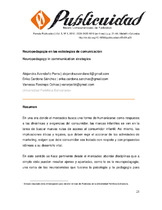Neuropedagogía en las estrategias de comunicación
Documentos PDF
Resumen
En una era donde el mercadeo busca una forma de humanizarse como respuesta a las dinámicas y exigencias del consumidor, las marcas infantiles se ven en la tarea de buscar nuevas rutas de acceso al consumidor infantil. Así mismo, las implicaciones éticas y legales, que deben regir el accionar de las actividades de marketing, exigen que éste consumidor sea tratado con respeto y con propuestas idóneas a su desarrollo vital. En este sentido se hace pertinente desde el mercadeo abordar disciplinas que a simple vista pueden resultar ajenas y apartadas, como lo es la neuropedagogía; una rama de las neurociencias que fusiona la psicología y la pedagogía para abordar al hombre como un ser social, desde las necesidades que esto exige, por ejemplo, a nivel cognitivo. Dicha disciplina aborda herramientas como la lúdica, la atención, la motivación, la curiosidad, entre otras, para entender y estimular el proceso de aprendizaje y el desarrollo cognitivo infantil. En este aspecto, se hace necesario hacer hincapié en la forma en que las marcas infantiles vienen ejecutando sus estrategias de comunicación y mercadeo, para así obtener un análisis sobre qué tanto estas, estimulan cognitivamente a sus consumidores, aportando así a su desarrollo y educación. La investigación descubre que son varias las marcas que han venido dando muestra de lo que en este sentido puede lograrse desde hace unos años, pero que las mismas no son conscientes de los grandes aportes que hacen a sus consumidores. De esta forma y según los objetivos de la investigación, se evidencia la alta pertinencia de incluir la neuropedagogía y las herramientas que esta aporta a los procesos de comunicación y mercadeo, con el fin de posicionar las marcas como aliadas de la educación y el desarrollo infantil, y a la vez imponer un mercadeo ético y sano, con conciencia y mayor conocimiento sobre un público joven y altamente sensible como lo son los infantes. In an era where marketing seeks a way to humanize itself in response to the dynamics and demands of the consumer, children's brands find themselves in the task of finding new routes for accessing to the children consumer. Likewise, the ethical and legal implications, which should govern the conduct of marketing activities, require that this consumer be treated with respect and with proposals suitable for their vital development. In this sense it becomes pertinent for marketing to deal with disciplines that at first glance may be alien and isolated, such as neuropedagogy; a branch of the neurosciences that fuses psychology and pedagogy to take the man as a social being, from the needs that this requires, for example at the cognitive level. This discipline addresses tools such as playfulness, attention, motivation, curiosity, among others, to understand and stimulate the learning process and children's cognitive development. At this point it is necessary to emphasize the way in which children's brands have been executing their communication and marketing strategies, in order to obtain an analysis of how much these cognitively stimulate their consumers contributing to their development and education. Thus this research discovers that there are several brands that have been showing what in this sense can be achieved for a few years, but they are not aware of the great contributions they make to their consumers. In this way and according to the objectives of the research, it is evident the high relevance of including neuropedagogy and the tools that this contributes to the communication and marketing processes, in order to position brands as allies of education and child development, and at the same time impose an ethical and healthy marketing, with awareness and greater knowledge about a young and highly sensitive public as are infants.
Palabra/s clave
Neuropedagogía
Neuromarketing
Desarrollo cognitivo
Neurociencia
Neuropedagogy
Cognitive development
Neuroscience
Colecciones
El ítem tiene asociados los siguientes ficheros de licencia:


